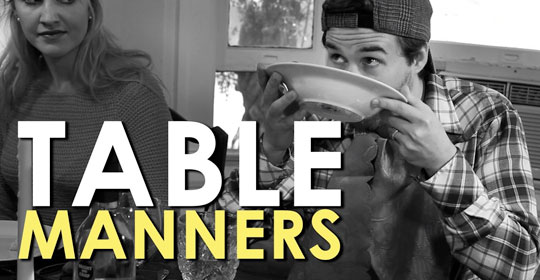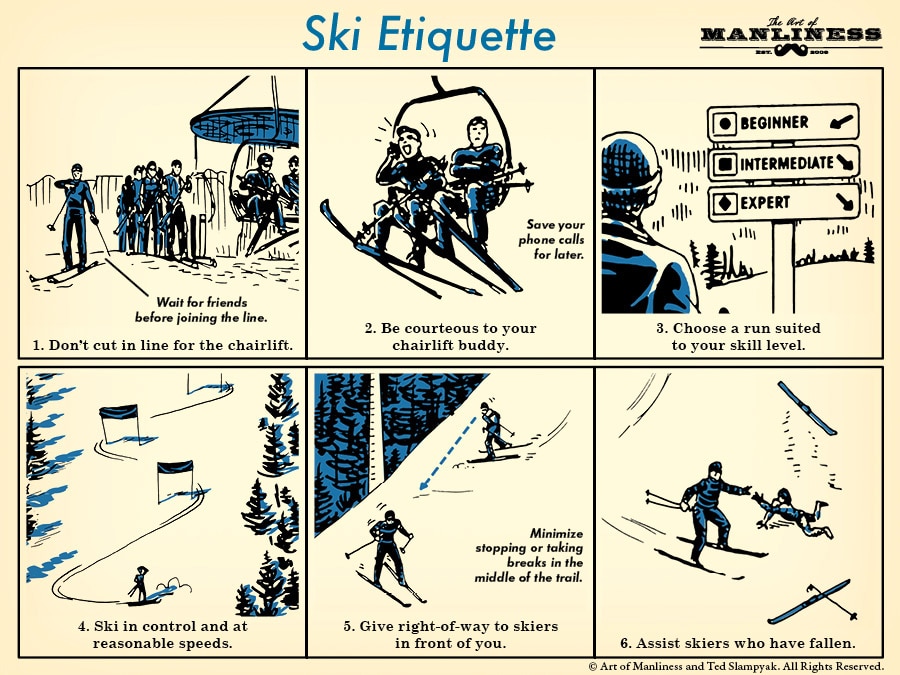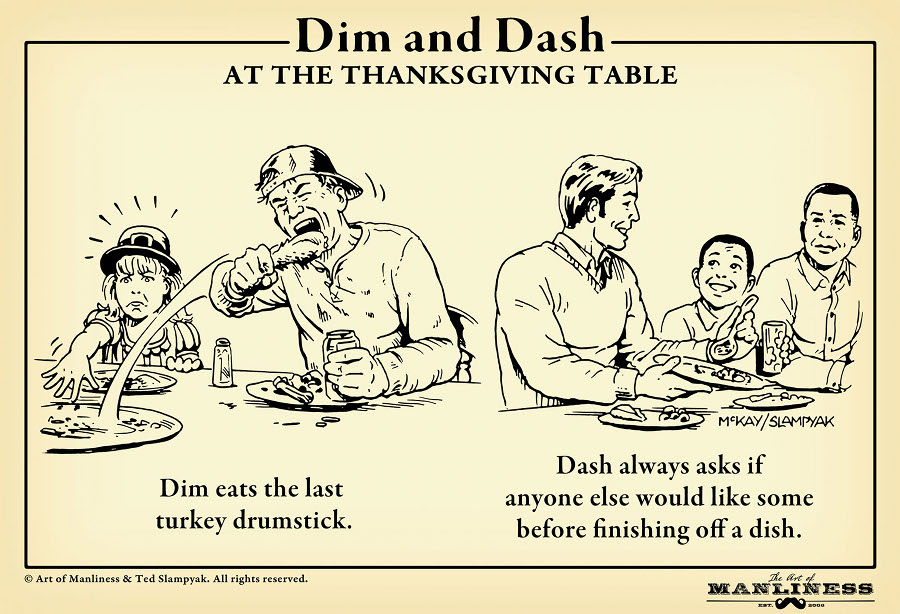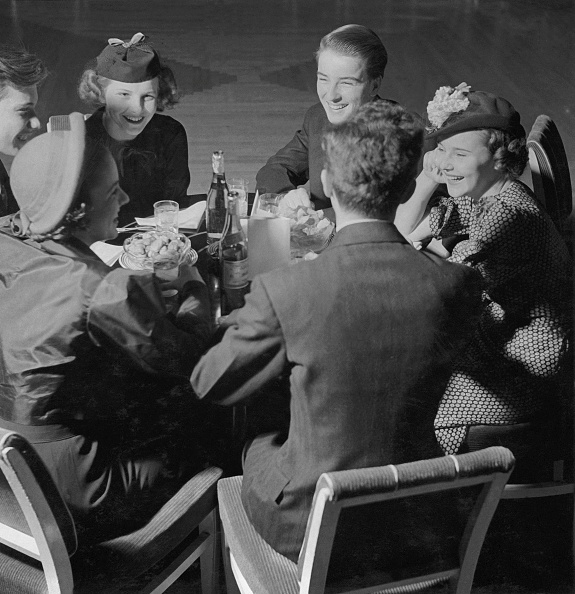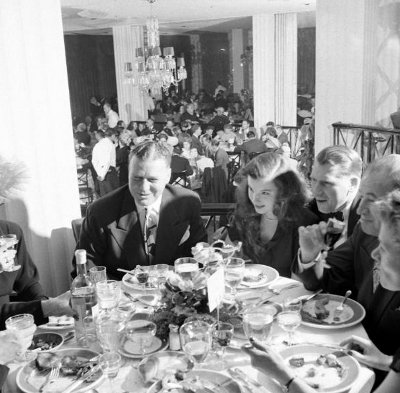
“Good manners will open doors that the best education cannot.” -Clarence Thomas
Why Table Manners Matter
As a young Marine Corps Officer, I was dumbfounded one afternoon when after training on the Mark19 we transitioned into a class on proper table manners. Taught by a petite older woman, the class covered the basics of dining etiquette. We practiced these skills at various unit dinners over the next six months. At the time, I thought the classes were useless and a waste of my time. Yet as it turns out, while I never again fired that heavy grenade launcher, the skills I learned those evenings concerning table manners have enhanced my enjoyment of dining for over a decade.
Whether dining with a 4 star general, toasting with a Medal of Honor recipient, or sitting with friends and family on Christmas Eve, an understanding of dining protocol makes time spent with others around a table more enjoyable. When you know the rules there is no awkwardness or questions about how things should be done; instead there is only opportunity to spend quality time with the company present.
Watch the Video
The Need for Better Dining Etiquette
When I began to spend more time outside of military circles I noticed that many men had never been taught proper dining etiquette. I was amazed when I returned to graduate school and met people who were spending 100K on their education but were sabotaging their own interviews over a meal that they ate from their plate like a horse. Still other times I would witness friends embarrass themselves by eating half the food on their plate before noticing everyone else was waiting to give thanks. A man in the year 2010, like his great-grandfather in the year 1910, still sits and eats three meals a day. The purpose of this article is to give you the basics to dine with respect like he did.
If nothing else, live by these four rules:
- Pay attention to your hosts – Being an observant diner and picking up on cues from your host will enable you to avoid 95% the embarrassing situations you could find yourself in. Simple things like waiting to eat until you see others eating and using the utensils others are using will enable you to “wing it.” However, this constant observing and following does not allow you to relax and enjoy the evening.
- Chew with your mouth closed and do not talk with food in your mouth – Yes, in the year 2010 we still have a problem with men chewing with their mouths wide open. And if you have something to say, refrain from filling your mouth the moment before. In order to recover if expected to speak, only put a single bite in your mouth at a time. The days of stuffing your mouth with as much food as it can hold are over.
- Bring your food to your face, not your face to your food – You shouldn’t be leaning over your food, shoveling it into your mouth with a distance traveled of only 6 inches. Instead, sit straight, balance a single bite on the utensil of choice and bring it directly to your mouth. And never drink from your soup bowl.
- Say Thank You, Please, and Excuse Me – These small words are magic and should be used liberally.
The First Rule of Dining Etiquette – Know Who You Are Dining with and the Setting
As the Boy Scout Motto goes, be prepared. RSVP within 3 days of receiving an invitation, or if no invitation was sent ask what to expect and how many people will be in attendance. Dress to the level you feel appropriate, you do not need a custom suit but I advise looking professional. It shows respect to the host and chances are you’ll be making important first impressions.
If you are visiting a person’s home, consider bringing a small gift such as flowers in a vase or a bottle of wine. If the meal is being hosted by a close friend, find out how you can help make their life easier – perhaps by bringing a dessert. Arrive on time, but not more than 10 minutes early as last minute preparations are always underway on the host’s end.
Informal Dining – Non-seated
By non-seated, I mean there will be no set time in which everyone sits around a table to dine as a group. Examples are picnics and barbeques where people arrive, eat, and leave at various times. And although table manners here are much more relaxed, there are still a few rules of dining etiquette you should pay attention to.
- Take an average sized serving – It is bad form to find you can only eat half the food on your plate and that your excess caused a fellow guest to miss out on the dish entirely. Going back for a second serving, assuming there is plenty, is always a compliment to the chef.
- Do not double dip – If you really like the dip, and need every part of your chip covered in it, use a spoon and make your own dipping station on your plate.
- Precutting meat– Cut for yourself and those immediately around you – do not cut the entire roast as it will cause the meat to dry out quicker.
- Clean-up after yourself – Do I need to say more?
Informal Dining – Seated

Informal Dinner Setting
By informal seated dining I mean that at some point all parties will be seated and a set meal will be served and conversation will take place over food. Examples are recruiting events, business meals, or Easter dinner with the fiancée’s family. Below is a place setting you might see. Note the word Luncheon could be substituted for breakfast or dinner, as you can see this set-up anytime of the day.
The general guidelines are this: everything revolves around the plate, forks to the left, spoons and knives to the right. When it comes to silverware, you start on the outside and work inward. Therefore, if in the picture above we had a fork for appetizers (which we do not), it would be to the left of the dinner fork (which is the one seen). Your glass, when not in use, should remain in the upper right area of your setting. Notice the water goblet is usually larger than your wine glass.
Formal Dining

Formal Dinner Setting
The first clue that you’ll be attending a formal dinner will be the uniform – suits and in many cases black tie are required. Although I will not be covering formal dining in this article – there is too much information to cover in a single post – don’t be too alarmed if you have one coming up. A man can learn the basics within 30 minutes of study and practice. The picture below will give you an idea of the set-up you’ll face.
The Napkin
Place your napkin in your lap within 1 minute of sitting at the table to dine. Do not tuck it into the front of your shirt collar like a bib or into your pants; unfold it just enough to cover your lap (usual leaving it half folded is enough, although fully unfolded is fine for larger men). Although it can serve to protect your trousers from a spill, its main purpose is to enable you to seamlessly remove food from the sides of your mouth. As such, use it when needed and when finished or excusing yourself from the table place it neatly to the left of your plate.
 Don’t hog all the food for yourself
Don’t hog all the food for yourself
When to Start Eating?
The simple and safe answer to this question is when others do. The reality is that it is often unclear, as that hot food is being served and the hostess along with a helper are still in the kitchen and a few guests are out wandering around out of earshot. In this case, if hot food is being served and at least two people are seated, you may begin. If the meal is orderly, and everyone is seated, then once three to four people have been served you may begin (assuming a group larger than 4 – if 4 or smaller wait for everyone to be served). The general guideline is to never eat alone, but to eat hot food while it is still hot.
A prayer, if to be said, should be initiated by the host but can be given by anyone. It should be given before the meal is served. Toasts, on the other, hand can happen anytime glasses are filled and except at formal events can be initiated by anyone; oftentimes a guest toasts the host for their hospitality.
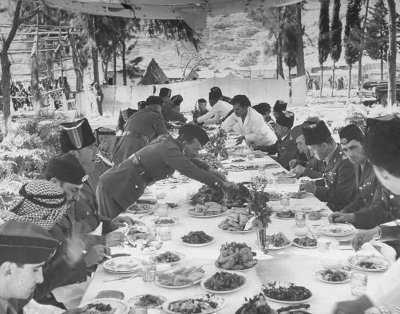 Don’t reach across the table
Don’t reach across the table
Elbows, Reaching, and Spills
Placing your elbows on the table while the meal is in progress should be avoided; however, there is nothing wrong with putting them on the table during a conversation between meals and during coffee or tea. Reaching on the other hand is never allowed; if anything is beyond your normal reach (meaning you have to rise from your seat to get to it) or is within another’s personal space, always ask the person closest to pass the item you need. And if something spills? First, deal with the item spilling and next do what you can to assist the host with the immediate clean-up. And then forget about it and enjoy your meal.
Dealing with Food You Do Not Want
- You simply do not want to try it – If you haven’t tried it, how do you know you won’t like it? Always try to take just a little of all dishes offered; sometimes that little stays on the plate after a single bite, but at least the host was not offended.
- You have a restrictive diet – Depending on how restrictive, you may want to notify your host beforehand so that they can make special arrangements. I recently hosted a dinner where a number of the guests were fasting for Lent. Although it required a little extra work, my wife and I were more than happy to accommodate our guest’s diet restrictions. If the event you are attending is large and the host is not easily accessible, you may want to eat well the meal before in the case you are forced to eat light that evening.
- Saying no to alcohol – Being a non-drinker, I have run into situations where alcohol consumption is expected by all men present. On many occasions when visiting family in Ukraine I have been pressured heavily to partake in traditional shots of Vodka. My solution here is to take one glass, toast with the family, and then touch it to my lips. This works for me, and now that I have built a reputation as a non-drinker the issue rarely arises. The key is whatever your decision when pressured to drink, keep your choice consistent and you will run into less problems and hurt feelings.
How to Signal You Are Finished
The proper way to signal you are finished with your meal is to place your knife and fork in the 4:20 position. Your fork should be closest to you with tongs pointed up, the knife with its cutting edge facing the fork’s tongs; not only does this tell a waiter or host that you are finished, it is the most stable position for your silverware when a person seeks to clear your place for dessert or drinks.
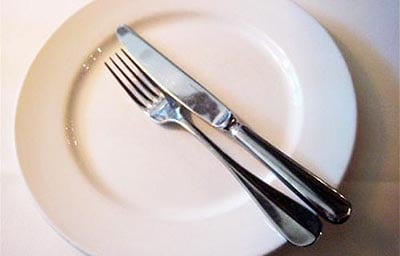 I’m Finished with my Meal
I’m Finished with my Meal
Saying Goodbye
Before leaving, say thank you to your hosts – all of them. If the event is large (more than 30 people) and you must leave immediately but your hosts are in the middle of entertaining other guests, you can pull a French leave and slip out without saying goodbye directly – in these situations it is prudent to ask a trusted friend, if present, to pass a goodbye message. However, a follow-up call or message within 24 hours is mandatory to explain why you departed without saying goodbye.
Final Tips
- Enjoy yourself and have a few drinks if you are so inclined; however do not ruin your host’s night by being the guy who after a half-dozen drinks starts making off-color comments and then argues loudly with his girlfriend.
- Talk with people – I mean, really listen to them, understand what they say, and have a good conversation. If you are the only person who has spoken for the last 10 minutes, you are not having a conversation – you are giving a presentation.
- Turn the cell phone off and enjoy the moment. Do not put it on silent, as nothing says “Our conversation is less important than some random call” than you peeking at your cell phone every 5 minutes. You can live without Twitter and Facebook for a night.
- The best way to acquire proper table manners is to practice them at every meal; make them a habit, teach them to your children, and when you need them they will be there.
“The dinner table is the center for the teaching and practicing not just of table manners but of conversation, consideration, tolerance, family feeling, and just about all the other accomplishments of polite society except the minuet.” -Judith Martin
Written by
Antonio Centeno
President, www.ATailoredSuit.com
Quality Custom Clothing & Sound Style Advice
Join our Facebook Page for a chance to Win Custom Clothing


